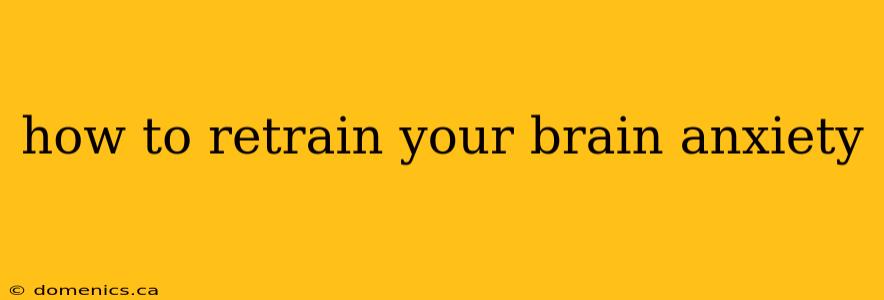Anxiety is a common experience, but when it becomes overwhelming, it can significantly impact your life. The good news is that your brain is remarkably plastic, meaning you can retrain it to respond differently to anxiety-provoking situations. This article explores practical techniques to help you manage and reduce anxiety by retraining your brain.
Understanding the Anxious Brain
Before diving into retraining techniques, it's helpful to understand how anxiety manifests in the brain. The amygdala, often called the brain's "fear center," plays a crucial role. When faced with perceived threats, the amygdala triggers a cascade of physiological responses – increased heart rate, rapid breathing, muscle tension – often experienced as anxiety. Chronic anxiety reinforces these pathways, making the brain more sensitive to perceived threats.
Retraining Techniques: Practical Steps to Reduce Anxiety
The key to retraining your brain for anxiety lies in weakening the fear response and strengthening coping mechanisms. Here are several effective techniques:
1. Challenge Negative Thoughts
Anxiety often fuels negative thought patterns. Cognitive Behavioral Therapy (CBT) is a highly effective approach to identify and challenge these thoughts. Learn to recognize and question negative self-talk. Replace catastrophizing ("This is a disaster!") with more realistic and balanced perspectives. For example, instead of "I'll fail this presentation," try "I've prepared well, and I can handle feeling nervous."
2. Mindfulness and Meditation
Mindfulness practices help you focus on the present moment, reducing the power of anxious thoughts about the future or regrets about the past. Regular meditation cultivates self-awareness, allowing you to observe your thoughts and feelings without judgment. Many guided meditation apps can help you get started. Even a few minutes daily can make a difference.
3. Exposure Therapy
Gradual exposure to anxiety-provoking situations can help desensitize your brain to fear. Start with manageable situations and gradually increase the level of exposure. This process, often guided by a therapist, helps break the cycle of avoidance that often fuels anxiety.
4. Physical Activity and Exercise
Exercise is a powerful tool for anxiety relief. Physical activity releases endorphins, natural mood boosters that combat stress and anxiety. Regular exercise also improves sleep quality, further contributing to mental well-being. Aim for at least 30 minutes of moderate-intensity exercise most days of the week.
5. Healthy Lifestyle Choices
A balanced diet, sufficient sleep, and limiting caffeine and alcohol all contribute to better mental health. These choices impact brain chemistry and function, reducing susceptibility to anxiety. Prioritize your physical health to support your mental health.
6. Breathing Exercises
Deep, slow breathing activates the parasympathetic nervous system, counteracting the "fight-or-flight" response associated with anxiety. Practice diaphragmatic breathing (belly breathing) regularly. There are many guided breathing exercises available online or through apps.
7. Cognitive Restructuring
This technique focuses on identifying and changing negative thought patterns and beliefs that contribute to anxiety. With practice, you can learn to recognize and challenge these thoughts, replacing them with more realistic and balanced perspectives.
8. Seek Professional Help
If anxiety significantly impacts your daily life, don't hesitate to seek professional help. A therapist can provide personalized guidance and support, helping you develop coping strategies and potentially using therapeutic techniques like CBT or exposure therapy.
Maintaining Your Progress: Long-Term Strategies
Retraining your brain for anxiety is an ongoing process. Consistency is key. Continue practicing the techniques you find most helpful, and be patient with yourself. There will be ups and downs, but with perseverance, you can build resilience and significantly reduce the impact of anxiety on your life.
Conclusion: Take Control of Your Anxiety
Retraining your brain to manage anxiety is achievable with dedication and the right tools. By incorporating these techniques into your daily life, you can develop a more positive and resilient approach to managing anxiety, taking control of your mental health, and enjoying a more fulfilling life. Remember, seeking professional support is a sign of strength, not weakness.
